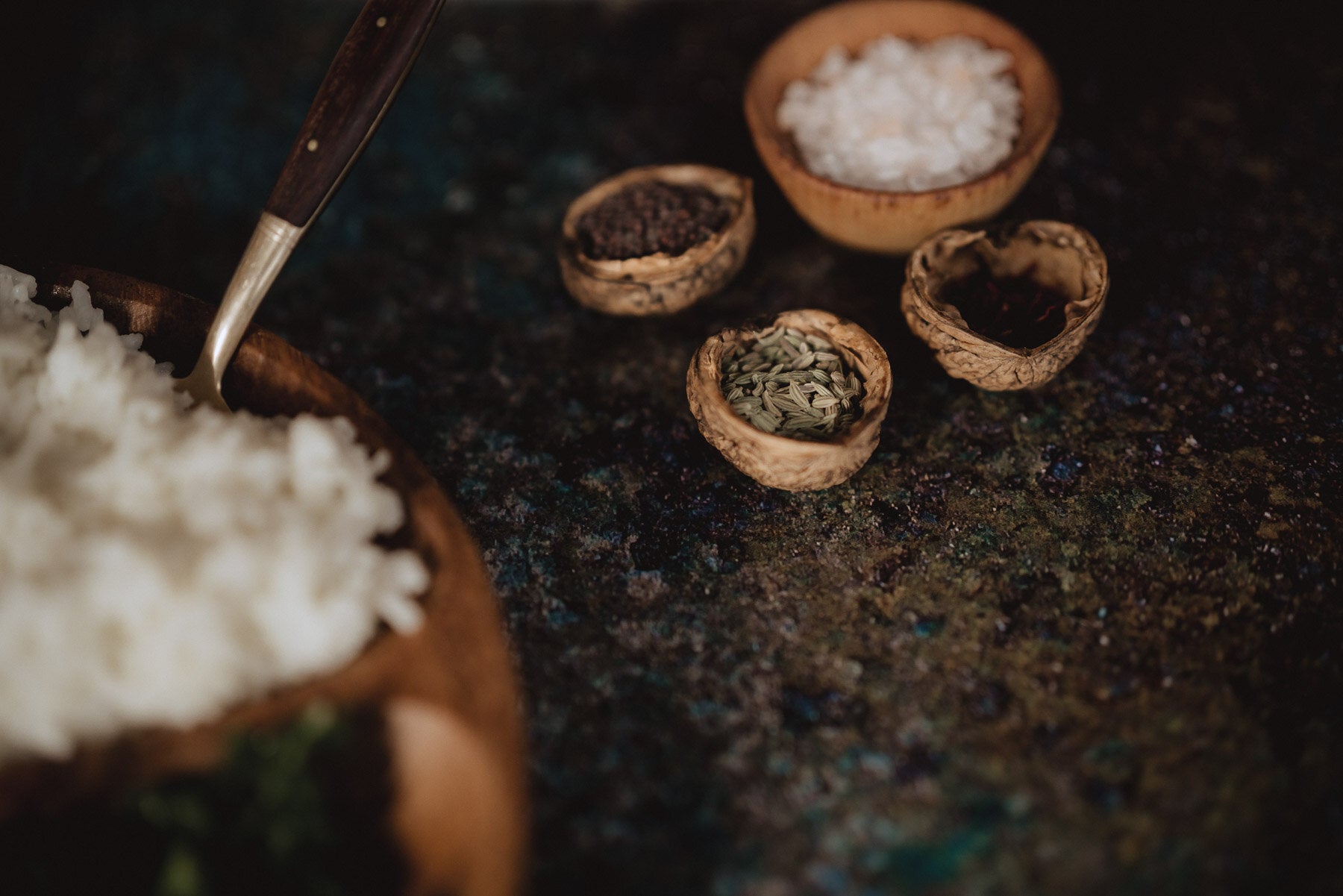How to set up your Ayurvedic kitchen
Ayurveda offers the foundation to reclaim your natural state of health and joy. When we approach “food as medicine”, each bite offers an opportunity to rediscover what it means to have harmony in body, mind and spirit. By making the commitment to cooking fresh food at home, your path to true health will become smooth and straightforward because you're taking ownership of what and how you eat.
Setting up an Ayurvedic kitchen doesn’t have to be expensive or complicated. In fact, you can clear clutter by giving away complicated gadgets to make room for the simple tools cooks have used for centuries to lovingly prepare meals.
We’ve compiled a list of the essentials every Ayurvedic kitchen should have. Once you have these items, all you need to bring a sattvic diet into your life are whole grains, legumes, fresh vegetables and a little love.

Cookware
What you cook with matters. Choose glass, copper, stainless steel, cast iron or stoneware cooking materials so you don’t serve toxic chemicals from non-stick or aluminum materials with your freshly prepared Ayurvedic food. Plus, cookware made from quality materials last longer than those made of cheaper materials.
- 1-2 pots with lids: A two and/or four-quart pot will work for most needs.
- 1 sauté or frying pan with a lid.
- 1 pressure cooker: Choose the size that makes the most sense for you. If you are cooking for a family of four, an eight-quart pressure cooker should be sufficient. Confused about how pressure cookers work? Here’s a quick guide to buying and using a pressure cooker.
- A good chef’s knife and a paring knife: Knives are tools to invest in, but you don’t need to buy a whole knife block. All it takes are two good knifes (keep them sharp by storing them away from other utensils or protected by a blade cover). Go to a store where you can pick up the knives before you buy. It should feel comfortable in your hands – not too heavy and not too light.
- Rice cooker: This tool makes cooking grain simple – just measure and cook. No need to set a timer or worry about heat settings. A three-cup cooker will make enough for 2 to 4 servings. Be sure it is labeled as having a stainless steel interior (many of them have stainless steel exteriors, but coat the interior bowl with chemical nonstick coatings). Look for one with a steamer insert – a handy tool to prepare vegetables and grain at the same time. You can also use a pressure cooker to cook rice.
- Electric pressure cooker, often called an instant pot. These are electric pressure cookers that can sauté, warm and pressure cook rice, beans, soups and more. They are equipped with delay start timers, which means you can set it up when you leave for work in the morning to start cooking in the afternoon so it's ready for you when you get home. Two of these can replace a rice and pressure cooker.
- Strainer: Choose one of a medium size with a fine mesh.
- 1-2 mixing bowls: These are often sold in sets of different sizes.
- 12 large wide mouth screw top jars: Toss the plastic storage containers and use these affordable jars to store your staples and homemade ghee. On the lid, write what's inside and when you purchased it (use a grease pencil or a piece of tape) since many grains look similar.
- Cooking utensils: You’ll need a wooden or stainless steel spatula, vegetable peeler, 1-2 serving spoons and a large wooden or stainless spoon for stirring veggies.
- Wooden cutting board.
- Small rolling pin: Making chapati is easy with a small rolling pin. You can also use a glass bottle in a pinch.

Ayurvedic pantry staples
Keeping a variety of grains and legumes on hand makes meal planning simple and grocery shopping less expensive.
True health comes from eating organically grown and seasonal products from trusted resources. Pesticides and genetically modified ingredients introduce toxins into our bodies, disturbing healthy digestion and leading to problems.
- Split and whole mung: Mung beans are one of the most nutritive and easily digested legumes. Split mung cooks quickly and is very easily digested. It’s great to have on hand for kitchari.
- White and brown rice: White rice is more cooling and has a lighter quality than brown. Have both in your pantry and listen to your body to find out what it needs at the time. There are plenty of varieties to choose from. Our favorites include basmati and jasmine varieties.
- Barley: A great choice for breakfast porridge or in place of rice. It makes great flour as well. Explore mixing this nutty grain with pesto as a delicious part of your meal.
- Adzuki beans: These cook quickly in a pressure cooker if they have been soaked for 6 to 8 hours.
- Brown or green lentils: More substantive than red lentils, these are a nice option for lunch or dinner
- Whole-wheat flour or the flour of your choice: It’s worth searching for a good source for freshly ground organic flour. The prana breaks down quickly after grinding, so buy it in small amounts and store away from the light or in the refrigerator. Better yet, invest in a grain mill to grind your own flour from the wheat berry, or whole grain of your choice.
- Basic Ayurvedic spices: Spices not only make food taste delicious, they also support digestive health. Be sure to store away from direct sunlight for maximum prana and taste.
- Mineral salt: Our bodies need salt to process nutrients and support proper brain functioning, but not all salt is equal. Table salt is a highly processed food containing chemicals that inhibit our ability to absorb the benefits we need from salt. It also increases kapha dosha, causing symptoms such as water retention and heart disease. Rock or mineral salt (we like Himalayan pink salt) contains the right balance of earth-based minerals allowing our bodies to get more out of our food. Keep in mind, when salt is cooked with the other spices it enhances the taste and provides digestive support. Adding salt to cooked food makes it too strong for your body and aggravates pitta dosha.

A few tips to get started
Meal planning: Cooking can and should be simple and enjoyable! Having a framework to approach meal planning makes the task easier and takes the guesswork out of grocery shopping. Use our balance bowl formula as your foundation for lunch and dinner each day. Once you learn the basic concept to bring balance, you'll be inspired to swap out different legumes, grains, vegetables and spices to create new, delicious meals.
How to make ghee: Ghee is a tridoshic oil infusing everything you cook with the qualities of sattva. It’s easy, less expensive, and very enjoyable (smells delicious when cooking!) to make your own. We like to make several batches at a time and store them in a dark cupboard so we always have some on hand. Use 1-2 tbsp per serving. Ghee is best used in each meal, daily.
Simple Ayurvedic Recipes: Myra Lewin’s Ayurvedic cookbook is filled with ideas to get you started on your journey to health. Having this cookbook on hand acts as a source of inspiration as you grow more comfortable with cooking without a recipe. We also have plenty of recipes on our blog to inspire your creativity in the kitchen. Remember, any cuisine can be approached in an Ayurvedic way - have fun adapting your recipes to be supportive to your health and well-being!
